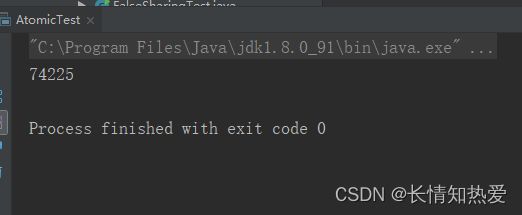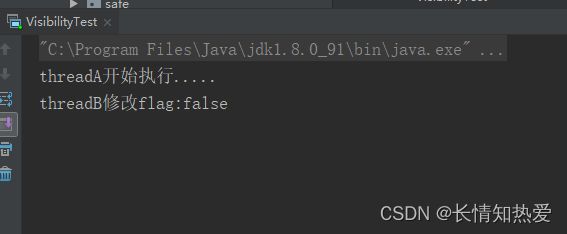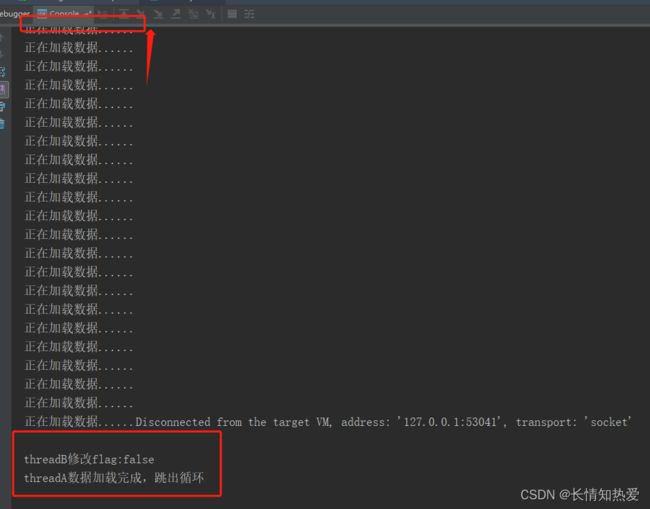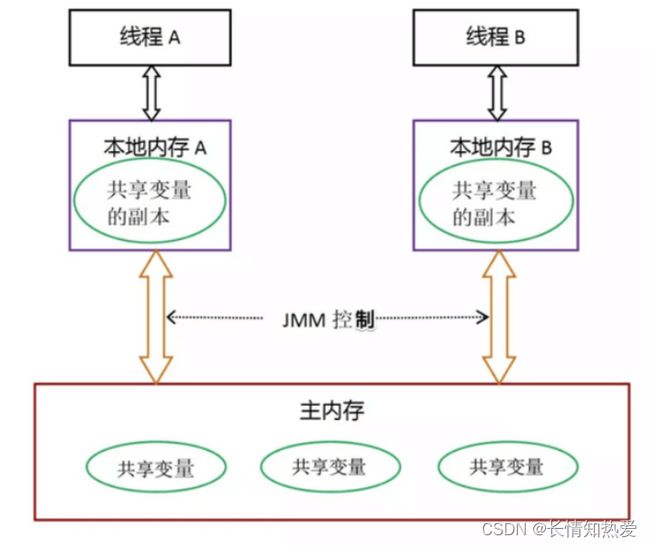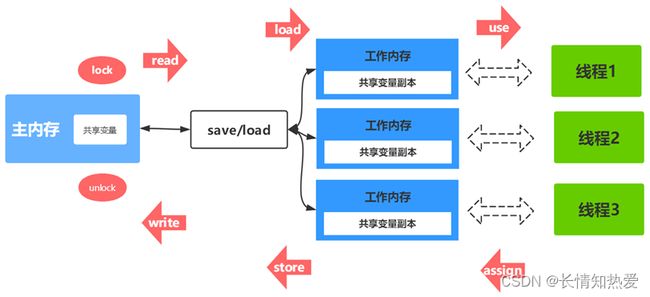并发编程 - 并发可见性,原子性,有序性 与 JMM内存模型
1. 并发三大特性
并发编程Bug的源头: 原子性 、 可见性 和 有序性 问题
1.1 原子性
一个或多个操作,要么全部执行且在执行过程中不被任何因素打断,要么全部不执行。 在 Java
中,对基本数据类型的变量的读取和赋值操作是原子性操作(64位处理器)。 不采取任何的原子性保障措施的自增操作并不是原子性的,比如i++操作。
原子性案例分析
下面例子模拟多线程累加操作
public class AtomicTest {
private static volatile int counter = 0;
public static void main(String[] args) {
for (int i = 0; i < 10; i++) {
Thread thread = new Thread(() -> {
for (int j = 0; j < 10000; j++) {
//synchronized (AtomicTest.class) {
counter++;
// }
}
});
thread.start();
}
try {
Thread.sleep(3000);
} catch (InterruptedException e) {
e.printStackTrace();
}
//思考counter=?
System.out.println(counter);
}
} 执行结果不确定, 与预期结果不符合,存在线程安全问题
如何保证原子性?
1.通过 synchronized 关键字保证原子性
2.通过 Lock锁保证原子性
3.通过 CAS保证原子性
思考:在 32 位的机器上对 long 型变量进行加减操作是否存在并发隐患?
https://docs.oracle.com/javase/specs/jls/se8/html/jls-17.html#jls-17.7
1.2 可见性
可见性是指当多个线程访问同一个变量时,一个线程修改了这个变量的值,其他线程能够立即看得到 修改的值。
可见性案例分析
下面是模拟两个线程对共享变量操作的例子,用来分析线程间的可见性问题
@Slf4j
public class VisibilityTest {
// volatile -> lock addl $0x0,(%rsp)
private boolean flag = true;
// private volatile boolean flag = true;
//private volatile int count;
public synchronized void refresh() {
// 希望结束数据加载工作
flag = false;
System.out.println(Thread.currentThread().getName() + "修改flag:"+flag);
}
public void load() {
System.out.println(Thread.currentThread().getName() + "开始执行.....");
while (flag) {
//TODO 业务逻辑:加载数据
//shortWait(10000);
//synchronized可以保证可见性
//System.out.println("正在加载数据......");
// count++;
//添加一个内存屏障 可以保证可见性
//UnsafeFactory.getUnsafe().storeFence();
// try {
// Thread.sleep(0);
// } catch (InterruptedException e) {
// throw new RuntimeException(e);
// }
//Thread.yield(); //让出cpu使用权
}
System.out.println(Thread.currentThread().getName() + "数据加载完成,跳出循环");
}
public static void main(String[] args) throws InterruptedException {
VisibilityTest test = new VisibilityTest();
// 线程threadA模拟数据加载场景
Thread threadA = new Thread(() -> test.load(), "threadA");
threadA.start();
// 让threadA先执行一会儿后再启动线程B
Thread.sleep(1000);
// 线程threadB通过修改flag控制threadA的执行时间,数据加载可以结束了
Thread threadB = new Thread(() -> test.refresh(), "threadB");
threadB.start();
}当flag没有volatile修饰时,不可见,执行结果线程A跳不出循环
运行结果:threadA没有跳出循环,也就是说threadB对共享变量flag的更新操作对threadA不可见, 存在可见性问题。
思考:上面例子中为什么多线程对共享变量的操作存在可见性问题?
当flag有volatile修饰时,具有可见性,执行结果线程A可以跳循环
当flag没有volatile修饰时,但是在load()方法内的while()中输出打印语句,如:System.out.println("正在加载数据......")后,,执行结果线程A还是可以跳循环,原因是println()方法内有synchronized (this),具有可见性。
当flag没有volatile修饰时,但是在load()方法内的while()中加上内存屏障后,执行结果线程A也是可以跳循环,具有可见性。
public class UnsafeFactory {
/**
* 获取 Unsafe 对象
* @return
*/
public static Unsafe getUnsafe() {
try {
Field field = Unsafe.class.getDeclaredField("theUnsafe");
field.setAccessible(true);
return (Unsafe) field.get(null);
} catch (Exception e) {
e.printStackTrace();
}
return null;
}
/**
* 获取字段的内存偏移量
* @param unsafe
* @param clazz
* @param fieldName
* @return
*/
public static long getFieldOffset(Unsafe unsafe, Class clazz, String fieldName) {
try {
return unsafe.objectFieldOffset(clazz.getDeclaredField(fieldName));
} catch (NoSuchFieldException e) {
throw new Error(e);
}
}
}
当flag没有volatile修饰时,但是在load()方法内的while()中线程睡眠的方法:如 Thread.sleep(0);后,执行结果线程A也是可以跳循环,sleep(0)方法内部调用了内存屏障,具有可见性!
当sleep中的时间值为0时,相当于调用了Thread.yield(); 让出cpu使用权
如何保证可见性
1. 通过 volatile 关键字保证可见性
2. 通过 内存屏障保证可见性
3. 通过 synchronized 关键字保证可见性
4. 通过 Lock锁保证可见性
1.3 有序性
即程序执行的顺序按照代码的先后顺序执行。 为了提升性能,编译器和处理器常常会对指令做重排 序,所以存在有序性问题。
有序性案例分析
思考:下面的Java程序中x和y的最终结果是什么?
public class ReOrderTest {
private static int x = 0, y = 0;
private static int a = 0, b = 0;
public static void main(String[] args) throws InterruptedException {
int i=0;
while (true) {
i++;
x = 0;
y = 0;
a = 0;
b = 0;
/**
* x,y的值是多少: 0,1 1,0 1,1 0,0
*/
Thread thread1 = new Thread(new Runnable() {
@Override
public void run() {
//用于调整两个线程的执行顺序
shortWait(20000);
a = 1; //volatile 写
// 内存屏障StoreLoad lock; addl $0,0(%%rsp)
UnsafeFactory.getUnsafe().storeFence();
x = b; //volatile 读
}
});
Thread thread2 = new Thread(new Runnable() {
@Override
public void run() {
b = 1;
y = a;
}
});
thread1.start();
thread2.start();
thread1.join();
thread2.join();
System.out.println("第" + i + "次(" + x + "," + y + ")");
if (x==0&&y==0){
break;
}
}
}
public static void shortWait(long interval){
long start = System.nanoTime();
long end;
do{
end = System.nanoTime();
}while(start + interval >= end);
}
}
执行结果:x,y出现了0,0的结果,程序终止。出现这种结果有可能是重排序导致的
如何保证有序性
1.通过 volatile 关键字保证有序性
2.通过 内存屏障保证有序性
3.通过 synchronized关键字保证有序性
4.通过Lock锁保证有序性
2. Java内存模型详解
在并发编程中,需要处理的两个关键问题:
1) 多线程之间如何通信(线程之间以何种机制来交换数据)。
2)多线程之间如何同步 (控制不同线程间操作发生的相对顺序)。
线程之间常用的通信机制有两种:共享内存和消息传递,Java采用的是共享内存模型。
2.1 Java内存模型的抽象结构
Java线程之间的通信由Java内存模型( Java Memory Model,简称JMM )控制,JMM决定一个 线程对共享变量的写入何时对另一个线程可见。
从抽象的角度来看, JMM定义了线程和主内存之间的抽象关系:线程之间的共享变量存储在主内 存中,每个线程都有一个私有的本地内存,本地内存中存储了共享变量的副本。 本地内存是JMM的一 个抽象概念,并不真实存在,它涵盖了缓存,写缓冲区,寄存器以及其他的硬件和编译器优化。
根据JMM的规定, 线程对共享变量的所有操作都必须在自己的本地内存中进行,不能直接从主内 存中读取 。
从上图看,线程A和线程B之间要通信的话,必须经历以下两个步骤:
1)线程A把本地内存A中更新过的共享变量刷新到主内存中
2)线程B到主内存中去读取线程A之前已更新过的共享变量
所以,线程A无法直接访问线程B的工作内存,线程间通信必须经过主内存。 JMM通过控制主内存与每 个线程的本地内存之间的交互,来为Java程序提供内存可见性的保证。
主内存与工作内存交互协议
关于主内存与工作内存之间的具体交互协议,即一个变量如何从主内存拷贝到工作内存、如何从工
作内存同步到主内存之间的实现细节, Java内存模型定义了以下八种 原子操作 来完成 :
lock(锁定): 作用于 主内存的变量 ,把一个变量标识为一条线程独占状态。
unlock(解锁): 作用于 主内存变量, 把一个处于锁定状态的变量释放出来,释放后的变量才可以被其他线程锁 定。
read(读取): 作用于 主内存变量, 把一个变量值从主内存传输到线程的工作内存中,以便随后的load动作使用
load(载入): 作用于 工作内存的变量 ,它把read操作从主内存中得到的变量值放入工作内存的变量副本中。
use(使用): 作用于 工作内存的变量 ,把工作内存中的一个变量值传递给执行引擎,每当虚拟机遇到一个需要 使用变量的值的字节码指令时将会执行这个操作。
assign(赋值): 作用于 工作内存的变量 ,它把一个从执行引擎接收到的值赋值给工作内存的变量,每当虚拟机 遇到一个给变量赋值的字节码指令时执行这个操作。
store(存储): 作用于 工作内存的变量, 把工作内存中的一个变量的值传送到主内存中,以便随后的write的操作。
write(写入): 作用于 主内存的变量 ,它把store操作从工作内存中得到的变量的值放入主内存的变量中。
Java内存模型还规定了在执行上述八种基本操作时,必须满足如下规则:
如果要把一个变量从主内存中复制到工作内存,就需要按顺序地执行read和load操作, 如果把变量从工作内存中同步回主内存中,就要按顺序地执行store和write操作。但 Java内存模型只要求上述操作必须按顺序执行,而 没有保证必须是连续执行。
不允许read和load、store和write操作之一单独出现。
不允许一个线程丢弃它的最近assign的操作,即 变量在工作内存中改变了之后必须同步到主内存中。
不允许一个线程无原因地(没有发生过任何assign操作)把数据从工作内存同步回主内存中。
一个新的变量只能在主内存中诞生,不允许在工作内存中直接使用一个未被初始化(load或assign)的变量。即就是对一个变量实施use和store操作之前,必须先执行过了assign和load操作。
一个变量在同一时刻只允许一条线程对其进行lock操作,但lock操作可以被同一条线程重复执行多次,多次执行 lock后,只有执行相同次数的unlock操作,变量才会被解锁。lock和unlock必须成对出现
如果对一个变量执行lock操作,将会清空工作内存中此变量的值 ,在执行引擎使用这个变量前需要重新执行load或assign操作初始化变量的值
如果一个变量事先没有被lock操作锁定,则不允许对它执行unlock操作;也不允许去unlock一个被其他线程锁定的变量。
对一个变量执行unlock操作之前,必须先把此变量同步到主内存中(执行store和write操作)
可见性案例深入分析
重点:结合可见性案例理解主内存和工作内存的交互过程
